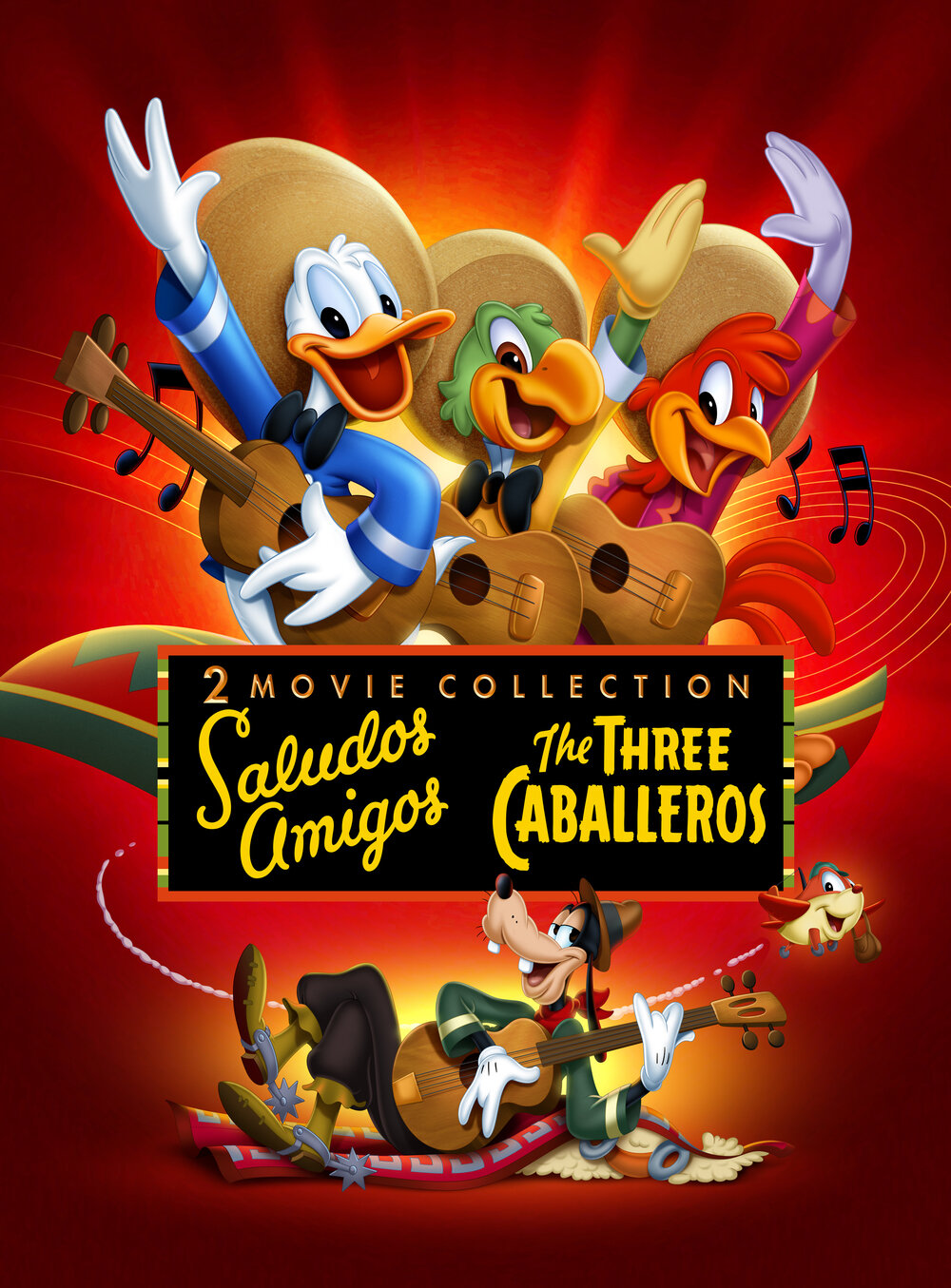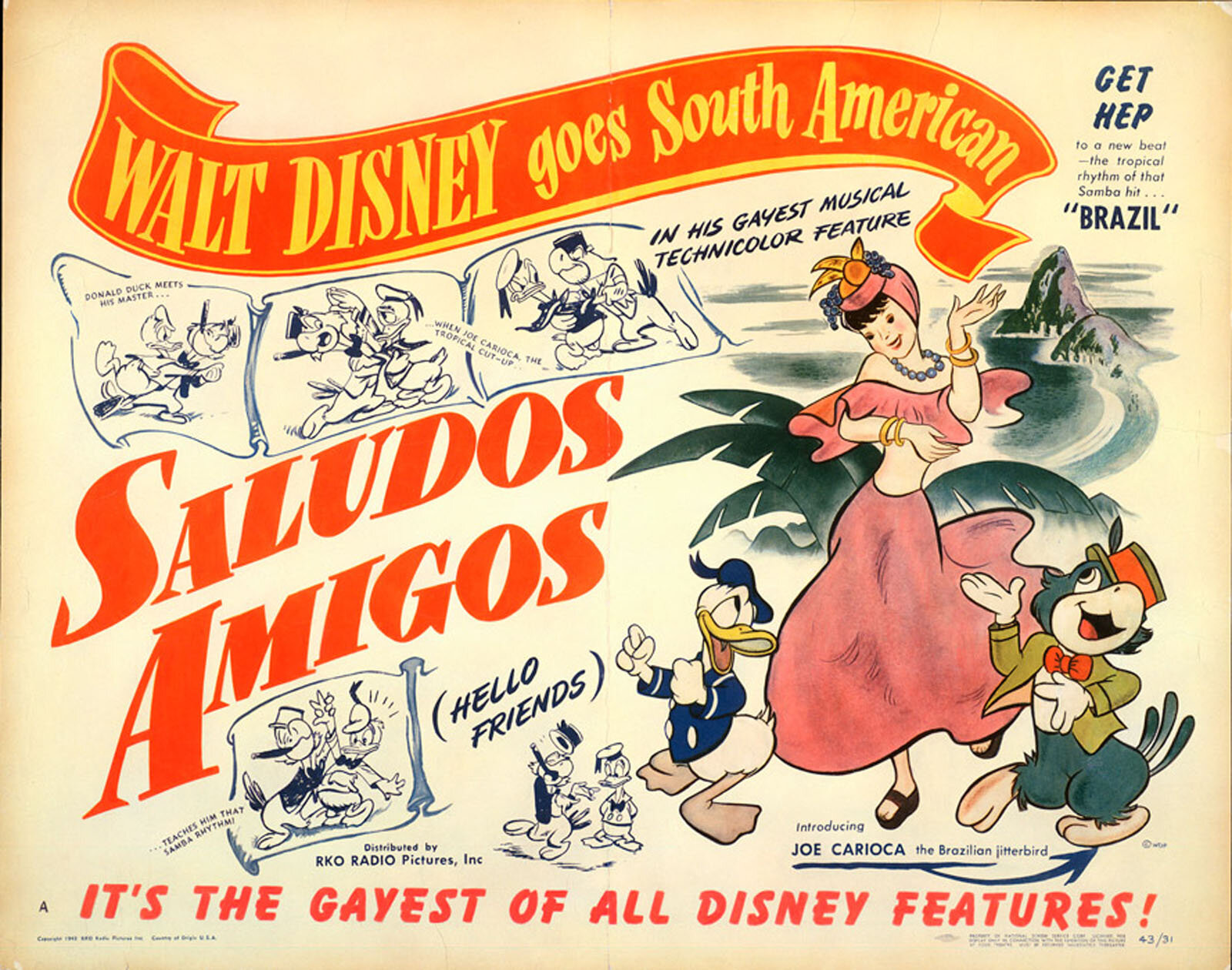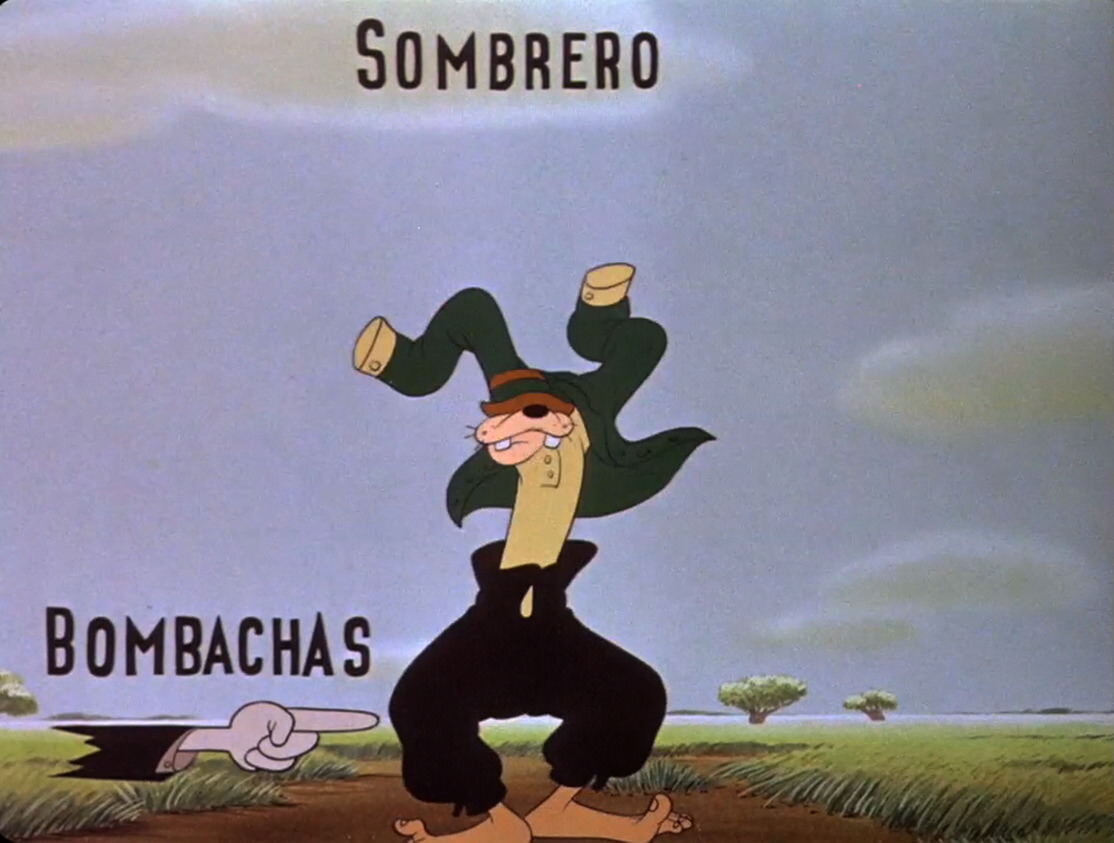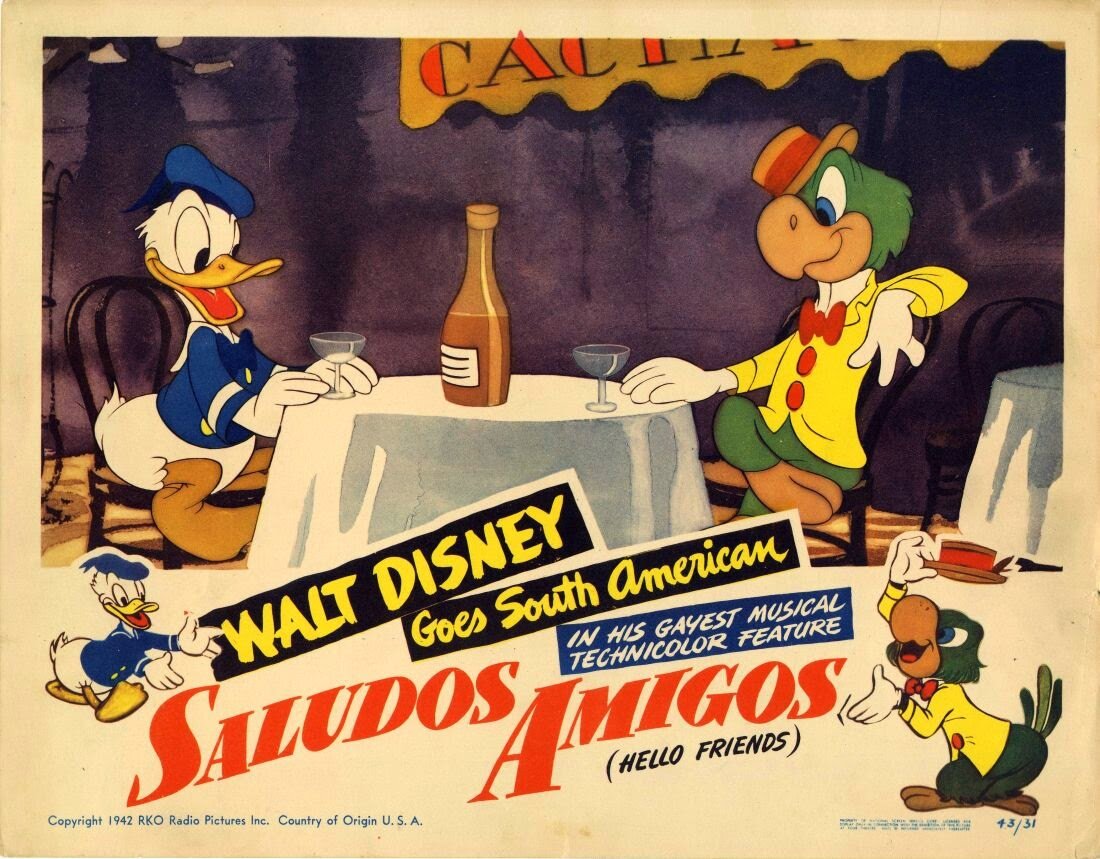Wild Disney Animation Month: Saludos Amigos (1942)
Little in pop culture and, indeed, life itself, has been romanticized and acclaimed quite like Walt Disney’s early days making feature films that would change cinema forever and play a huge role in determining how we see ourselves as Americans and how we are seen by the rest of the world.
So it can be difficult to believe that back when Disney was making movies like Fantasia it was struggling financially and consequently extremely receptive when the United States government came to them with a proposition.
The powers that be were worried about inroads Nazi Germany were making in Latin America. Uncle Sam wanted to win the hearts and minds of our neighbors to the South before they fell under Hitler’s sinister spell so the government wanted Disney’s finest craftsmen to travel to South America on a unique goodwill mission.
At the behest of the State Department and a young, devastatingly sexy Nelson Rockefeller, roughly twenty or so Disney writers, animators and craftsmen took a working vacation to South America, primarily Brazil, Argentina, Chile and Peru to research their traditions, customs and regional costumes.
The Disney craftsmen were to then use what they’d learn from their big group outing to make cartoons that would serve a series of noble purposes. First and foremost, the cartoons would strengthen the relationship between our country and powerful nations like Brazil and Argentina by educating the American people about their ways.
Disney would use laughter, joy and music to build a cultural bridge between a country it would soon come to symbolize, for better and worse, and the economic powerhouses of South America.
The Disney employees would use what they had learned to educate while entertaining and, perhaps best of all, the work would put much-needed money in Disney coffers and help finance their ambitious slate of feature films.
Disney could make money, serve its country, enjoy a scenic vacation in some of the most beautiful places in the world AND fight the creeping influence of Adolf Hitler at the same time.
It was the very definition of a win-win proposition. The expedition eventually resulted in The Three Caballeros but first it spawned the screamingly minor Saludos Amigos.
Saludos Amigos can’t help but feel minor to the point of insignificance next to Disney productions of the time like Pinocchio or Dumbo. But Saludos Amigos doesn’t need to be compared to towering all-time masterpieces to seem forgettable and slight.
That’s because Saludos Amigos is what’s known as a “package film” or a group of thematically connected short films designed to fill theaters with product until the next full-length Disney masterpiece was ready.
The names of Disney’s first feature films are legendary and known by all: Snow White and the Seven Dwarves, Pinocchio, Dumbo, Fantasia. The names of its package films, however are known primarily to animation buffs and Disney fanatics: Saludos Amigos, Make Mine Music and Fun and Fancy Free.
Disney’s shortest animated feature, as well as one of its slightest, Saludos Amigos stitches together four animated short films inspired by Latin America with documentary footage of the animators and artists and their picaresque adventures.
Donald Duck, the ultimate ugly American, stars in two of the short films while his attitudinal antithesis—mellow, laconic, agreeable Goofy—takes center stage in another while Pedro, an almost painfully adorable anthropomorphic plane, stars in the remaining vignette.
Saludos Amigos sometimes sags under the weight of its good intentions and mandate to inform as well as educate. At its weakest and driest, it can feel like an animated Wikipedia entry with sight gags.
Yes, the facts come fast and furious in a way that makes it difficult to retain any of them in cartoons like “Lake Titicaca”, which takes its filthy, filthy name from its setting in the famous body of water on the border of Bolivia and Peru.
The kick-off cartoon finds a narrator with a voice that sounds look it could only come from someone wearing formal attire dispensing factoids while excitable tourist Donald Duck tussles with a bull-headed lama as they attempt to cross a perilous rope bridge high in the mountains.
It’s a perfectly passable piece of animal slapstick with a characteristically apoplectic Donald Duck responding to the narrator’s words with white hot comic rage but there’s otherwise not much to distinguish it from other Donald Duck cartoons.
The second segment anticipates the disturbingly anthropomorphic vehicular universe of the Cars and Planes universe through the story of Pedro, a sentient plane and the proud progeny of a heroic and macho male mail plane and a lady plane.
“Pedro” is almost oppressively cute (this is Disney, after all) but also weirdly limited in its world-building. It establishes that Pedro went to a plane school where it learned plane history and other subjects of interest to anthropomorphic flying machines but we don’t see any students other than Pedro.
Say what you will about Cars and the less than distinguished place it inhabits in the Pixar pantheon but at least it had more than just three cars.
Big-eyed, lovable little Pedro the sentient boy plane finally gets a chance to prove himself when his father has a cold and it falls upon his son to deliver the mail through a ferocious storm and some terrifying obstacles.
“Pedro” goes to perverse lengths to make us think that poor little Pedro, the plucky sentient plane FUCKING DIED DURING HIS FIRST PROFESSIONAL FLIGHT.
“It’s too bad it had to end this way” the narrator somberly observes, hailing Pedro as “another martyr to the mail service.” It’s all an elaborate fake-out, however, as Pedro went down in the big storm alright but he somehow managed to muddle through and return home, weary and wet and exhausted but triumphant.
The kicker? Pedro went through all that hassle to retrieve and deliver a single stupid postcard. Incidentally, a Chilean cartoonist popularly known as Pepo was so insulted by how he perceived Chile as being portrayed in “Pedro” that he created a cartoon Condor named Condorito as a more heroic and accurate depiction of the Chilean people.
Goofy takes center stage in “El Gaucho Goofy”, which compares and contrasts the customs, garb and traditions of the noble American cowboy, as represented by Goofy, with his Argentine counterpart the Gaucho.
This was the only segment where I learned something in addition to being moderately entertained. I learned that the Gaucho’s saddle set-up is more elaborate than a cowboy’s so that it could be used as bedding when a cowpoke had to mosey on off to Sleepy Town.
Saludos Amigos peaks in “Aquarela do Brasil”, its four and final sequence, which finds a loose and limber Donald Duck, his uptight spirit liberated by lilting Latin beats, boogying on down to Brazil to meet up with José Carioca.
Carioca’s a sharply dressed Brazilian parrot whose signature accessory is a big cigar. Carioca returned in The Three Caballeros alongside the even more inappropriate Panchito Pistoles, who never went anywhere without his signature murder weapons.
Rumor has it there was once a fourth caballero known as Pedro Porno for the spank mag he was always carrying around and showing people but he was ultimately nixed as too vulgar and adult.
Needless to say when Disney brought back Jose Carioca and Panchito for a recent Three Caballeros cartoon they made changes to make them more politically correct and by “politically correct” I of course mean “less wildly, nonsensically inappropriate.”
This final cartoon has a glorious sense of musicality and an intoxicating dream logic. It’s the first time the film really seems to be engaging with South America as artists rather than as tourists.
Saludos Amigos only really comes alive during its final segment, when it shakes off its inveterate American whiteness and gives into an intoxicating samba rhythm. It’s a wonderfully, intentionally disorienting sequence, in part because Jose Carioca initially speaks in untranslated Portuguese before switching to English for the sake of Donald and the American audience.
That seems appropriate considering that Saludos Amigos is half-remembered today for the fascinating story behind its creation, a tale told in the engaging 2008 documentary Walt & El Grupo, and as a warm up for Three Caballeros.
Saludos Amigos had to walk, albeit to an infectious beat, so that The Three Caballeros could soar.
Pre-order The Joy of Trash, the Happy Place’s upcoming book about the very best of the very worst and get instant access to all of the original pieces I’m writing for them AS I write them (there are six so far, including Shasta McNasty and both seasons of Baywatch Nights) AND, as a bonus, monthly write-ups of the first season Baywatch Nights you can’t get anywhere else (other than my Patreon feed) at https://the-joy-of-trash.backerkit.com/hosted_preorders
AND of course you can also pledge to this site and help keep the lights on at https://www.patreon.com/nathanrabinshappyplace
Support Travolta/Cage by pledging to our Patreon at https://patreon.com/travoltacage
Missed out on the Kickstarter campaign for The Weird A-Coloring to Al/The Weird A-Coloring to Al-Colored In Edition? You’re in luck, because you can still pre-order the books, and get all manner of nifty exclusives, by pledging over at https://the-weird-a-coloring-to-al-coloring-colored-in-books.backerkit.com/hosted_preorders










